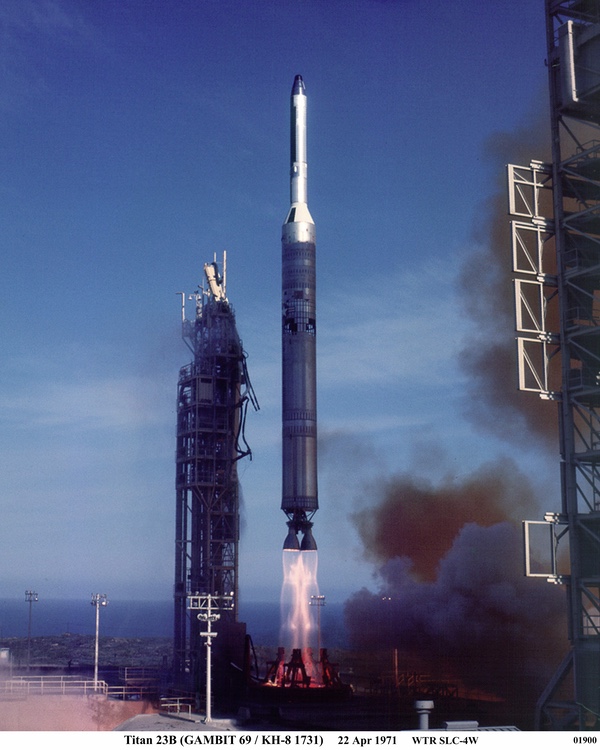FROG: The Film Read Out GAMBIT programby Dwayne Day
|
| The goal for the near-real-time system was to get images to eyeballs in an hour or less. FROG was considered by many to be the easier, cheaper, and quicker way to accomplish that goal. |
FROG stood for Film Read Out GAMBIT, and it was KENNEN’s primary competitor in the effort to develop satellites that could return their images to Earth faster than the systems flown throughout the 1960s and into the 1970s. These early satellites exposed film that was wound up into reentry vehicles that were then ejected to Earth. Those systems, with names like CORONA, GAMBIT, and HEXAGON, often could not get a satellite image to a photo-interpreter’s desk in Washington until five or more days after they were taken—sometimes weeks—but could cover many targets during each mission. The goal for the near-real-time system was to get images to eyeballs in an hour or less. FROG was considered by many to be the easier, cheaper, and quicker way to accomplish that goal. FROG was approved for development in 1971, only to be canceled six months later.
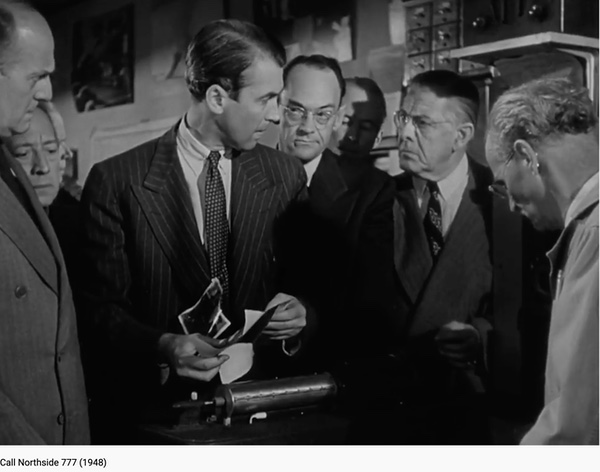 Images from the 1948 Jimmy Stewart movie Call Northside 777 showing how newspapers relayed photographs over telephone lines. A variation of this technology was later adapted for satellite use. (credit: 20th Century Fox) 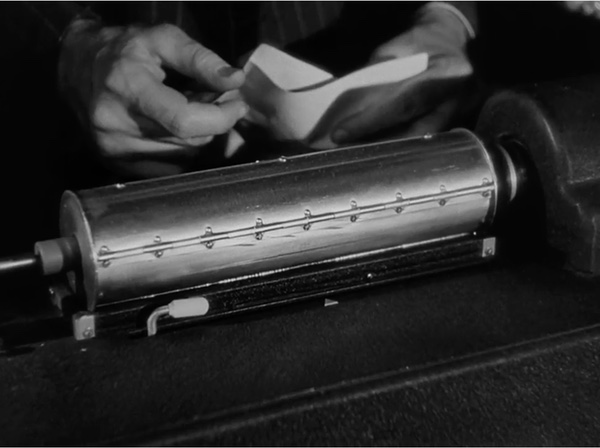 |
The origins of FROG
In 1956. the Air Force began development of a satellite capable of exposing film in orbit, developing the film using a “Bimat” process that was the equivalent of pressing the film against a sponge saturated with a development chemical, and then scanning the developed film with a “flying spot scanner.” The light pulsed from the scanner would be converted into signals that were then beamed to the ground. Variants of this technology had been in commercial use at newspapers for a decade, enabling photographs to be transmitted great distances over phone lines.
By 1958, the satellite program continued to evolve until it was eventually named Samos. The first satellite, known as the Samos E-1, used the “film-relay” process to produce low-resolution photographs from space. The follow-on Samos E-2 program used the same process to produce higher-quality images. The first Samos E-1 satellite launched in October 1960 and failed to reach orbit. The second launched in January 1961 and had limited success. The Samos E-2 program had a single launch in September 1961, which ended in failure.
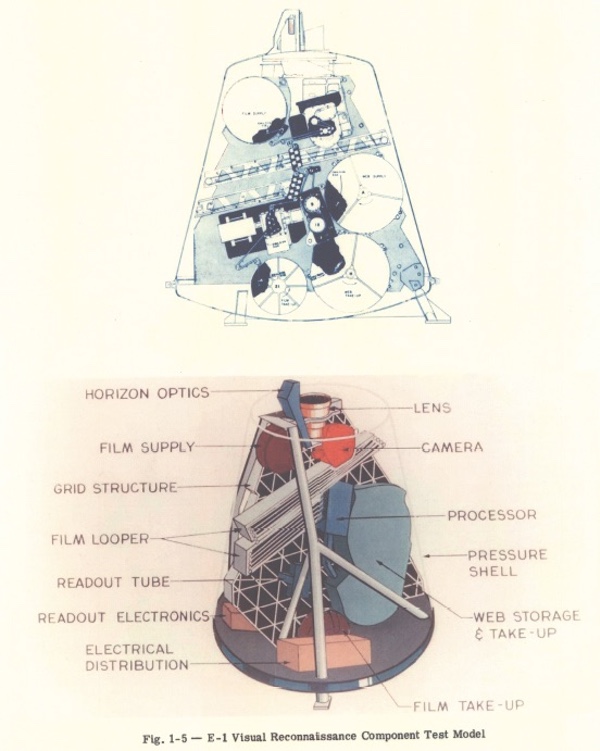 Schematic of the Samos E-1 satellite launched in 1960. The E-1 and similar Samos E-2 used film-readout technology to take a photo, develop it onboard the satellite, and scan the film, relaying the image over a radio link to a ground station. The E-1 and E-2 were both canceled because of technology limitations. (credit: NRO) |
A major limitation of the Samos film-relay program was that the satellite could only transmit at most a few dozen images to the ground per day, and these would be at relatively low resolution. Scaling the system up to provide more images per day would have required a large number of satellites and ground stations. The Samos E-1 and E-2 programs were canceled in 1961. By this time, the CORONA satellites were being launched and recovered regularly. Instead of relaying imagery to the ground, CORONA recorded the images on film that was returned to Earth in a reentry vehicle. Although it took longer to return and process the film, each CORONA satellite could photograph far more territory during its short time in orbit than a Samos mission operating for a longer period of time. By 1963, CORONA was supplemented by a higher-resolution reconnaissance satellite known as GAMBIT. CORONA would scan large areas so that analysts could detect new construction, and GAMBIT would take photographs of smaller areas that showed targets in greater detail.
In 1963, the NRO agreed to the transfer of Samos film-readout technology to NASA for use in the Lunar Orbiter program. The technology proved successful, although Lunar Orbiter had to produce fewer photos than an operational reconnaissance system. Five Lunar Orbiter missions flew, from August 1966 to August 1967, all of them successful.
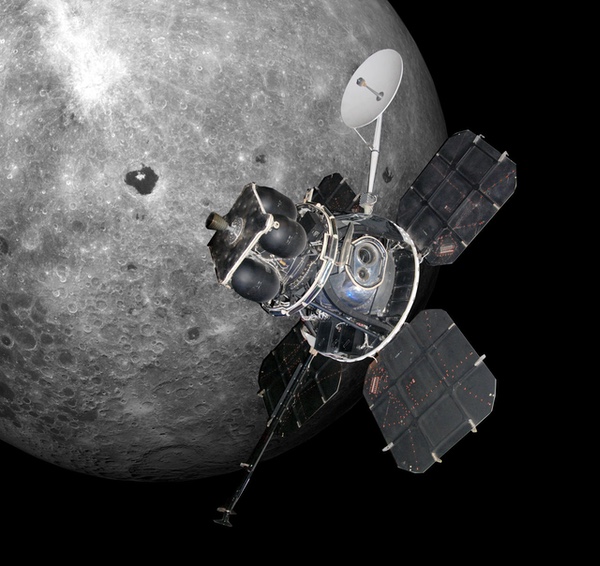 NASA's Lunar Orbiter successfully used technology developed for the Samos E-1 and E-2 programs. The agency operated five Lunar Orbiters between 1966 and 1967. (credit: NASA) |
Some low-level research on various film-relay technologies continued after the Samos cancellation. By 1965, the Air Force NRO component located in Los Angeles and known as the Secretary of the Air Force Special Projects office, or SAFSP, was evaluating the possibility of merging film-readout technology with the GAMBIT optical system.
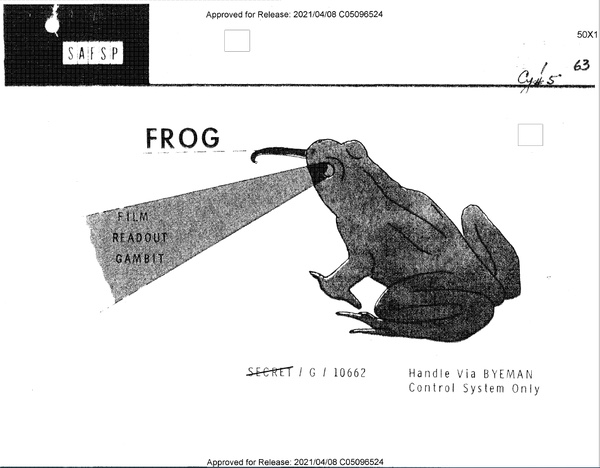 Cover of a report describing the Film Read Out GAMBIT (FROG) system. Although there was some discussion of changing the name, it was rejected as unnecessary. (credit: NRO) |
GAMBIT Readout Experiment
In summer 1965, Brigadier General John L. Martin Jr., who had taken over from Major General Robert Greer as director of SAFSP, sponsored the “GAMBIT Readout Experiment,” which had the goal of testing in orbit operation of a combination of readout devices and GAMBIT optics. The goal was to fly a satellite that could transmit imagery of four feet (1.2 meters) or better, covering “a useful number of targets per day.”[1] This was to be an experiment, not an operational system. But no actual space test was undertaken. Martin’s proposal was not accepted. However, two technology studies were funded by NRO, undertaken by Bell Telephone Laboratories and CBS Laboratories.[2]
| Carroll’s memo is the first known mention of flying an interim readout system based on GAMBIT to be followed by a more sophisticated system in the 1970s. |
In January 1966, the Committee on Overhead Requirements (COMOR), which established requirements for both photographic and signals intelligence satellites, indicated there was need for quick response satellite imagery and concluded that readout capability for GAMBIT would be a worthwhile investment.[3] Although it is not entirely clear, this statement from COMOR may have prompted the NRO to propose a new operational spacecraft known as Film-Readout GAMBIT, usually shortened to FROG. Whereas the GAMBIT Readout Experiment was a proposal for an experimental test, FROG would be based upon the high-resolution GAMBIT-3 satellite that was just entering service. FROG would be an operational imagery satellite to supplement other satellites in service. GAMBIT-3 used a powerful camera to expose large format film in long strips. The film was wound up into a reentry vehicle which would later separate from the spacecraft, enter the atmosphere, and be recovered in mid-air while hanging from a parachute. FROG would replace the reentry vehicle with a system for developing the film and scanning it with a laser—an improvement over Samos’ flying spot (i.e., white light) scanner. The scanned film would be converted into electronic analog signals which would be transmitted to a ground station.
The new proposal was for FROG to operate for 30 to 90 days, be able to read out imagery three to four times each day, transmit to a ground station, and provide a ground resolution of three to five feet (0.9–1.5 meters). While an image might be available in as little as 20 minutes after it was obtained, for high target density areas it might take five days until the satellite could be in position to take a photograph. Its proponents believed that FROG could achieve initial operational capability by November 1968.[4]
John S. Foster Jr., the Pentagon’s Director of Defense Research and Engineering, wrote to Lieutenant General Joseph Carroll about the new technology capability. Carroll was the head of the Defense Intelligence Agency, the DoD’s equivalent to the CIA. Foster noted that an early demonstration scanning system had “remarkably good” performance, “resulting in relatively little resolution degradation.” But Foster warned that it would be difficult to justify the cost of such a system “if a crisis management situation at some unknown time in the future was its only justification.” Foster wanted Lieutenant General Carroll’s input on “what current intelligence needs this type of system can satisfy and your view of what possible new concepts in intelligence collection could be developed given the availability of such technology.”[5]
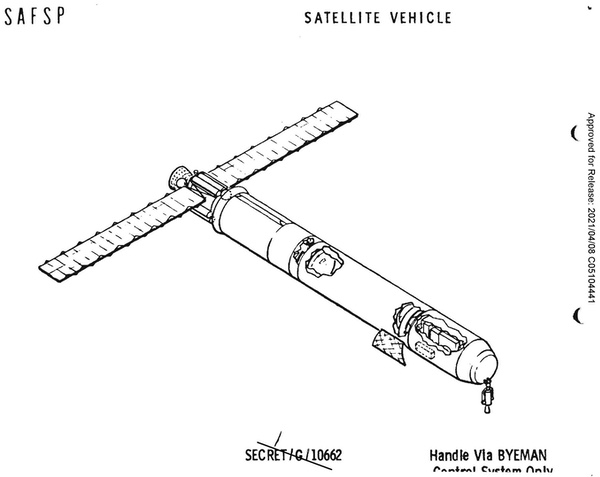 FROG would have used the proven Agena spacecraft, which also served as a second stage. The goal was for a 1-year orbital lifetime. The plan was for 2.8 launches per year to maintain a two-satellite constellation. (credit: NRO) |
In March 1966, Carroll replied to Foster about the value of readout to intelligence collection. “DIA has previously stated the requirement for a quick response, near-real-time readout satellite reconnaissance system as a matter of highest priority.” Although the GAMBIT readout system would not meet all of DIA’s requirements, it would provide “a unique high resolution readout capability which represents a most important breakthrough in providing the timely response so critical for intelligence in crisis situations.” Carroll continued: “The more sophisticated systems which may respond to the total requirement appear to be in the 1972-1975 time frame, therefore, the G-3/RO appears to be a logical and practical interim system in meeting this requirement. Nevertheless, crisis management alone is probably not sufficient justification for continued development especially from the standpoint of cost effectiveness.”[6] Carroll’s memo is the first known mention of flying an interim readout system based on GAMBIT to be followed by a more sophisticated system in the 1970s.
The GAMBIT-3 satellite which was about to launch for the first time was intended to provide high resolution photography for detailed technical data to support analysis of Soviet advanced weapon systems and technology. For example, it could produce accurate measurements of the diameter of a missile, or the details of a ship under construction. This was a vital mission, but it was not the highest priority or the greatest need for the intelligence community. Carroll noted that more than 50% of the required intelligence information could be provided by a satellite with approximately three-foot/one-meter ground imagery. “This includes priority indications/warning targets as well as surveillance objectives.” The HEXAGON satellite was then under development and when it was launched a few years later would—if it worked properly—provide the majority of the required imagery. “The G-3/RO system which is predicted to have a comparable resolution to the HEXAGON and a capability to photograph over 300 targets per day on a 30-day mission, can effectively augment the HEXAGON in a surveillance role and provide for increased flexibility of collection activities because of the near real-time readout capability.”[7]
Carroll explained that intelligence collected on a specific Soviet activity that was deleted from the report—but was probably strategic forces exercises—was currently inadequate. “Frequently it is difficult if not impossible to determine if activities detected are in fact occurring or are merely exercises; and activities conducted under complete or partial communications security may not be detected at all,” Carroll wrote.[8]
Carroll considered the readout system to be complementary to the GAMBIT-3 and HEXAGON film-return systems “for it will provide increased flexibility in operations and the opportunity for new and unique collection methods.” It could be phased in to “provide an economical mix of vehicles in the schedule which would not exceed the number of launches planned for that time period.”[9]
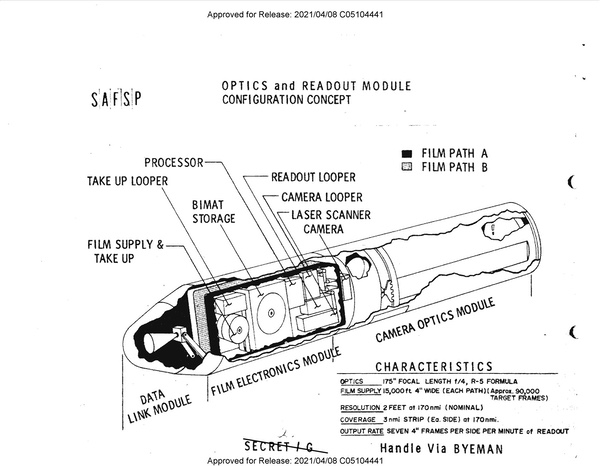 FROG would have used the existing GAMBIT-3 (also known as the KH-8) optics, with a film-processing system replacing the reentry vehicles. (credit: NRO) |
FROG on ice
In August 1966, the NRO’s Executive Committee, or ExCom, which had been created to establish policy for the NRO and negotiate disputes, and was chaired by the Deputy Secretary of Defense, met to discuss various national reconnaissance issues. The ExCom included representatives of both the Air Force and the CIA, and during this meeting they approved funding for CBS and Bell Telephone Laboratories to continue research on readout technology at least through January 1967.[10]
| Although little work on FROG took place during this time, the program was still considered to be a potential competitor for a near-real-time reconnaissance satellite. |
On November 17, 1966, the Committee on Overhead Requirements indicated that there was no urgent requirement for a crisis warning satellite system—contradicting its January conclusion.[11] Despite this, NRO officials still sought to preserve the ability to launch a vehicle with readout by January 1969. They planned for three sets of flight hardware. Their plan to keep the program alive involved performing minimum hardware change studies that looked at using the GAMBIT-3 vehicle with the reentry vehicle section removed and a read-out module added, and changing the film speed drive for a higher orbit (206 nautical miles—382 kilometers—as opposed to the more typical GAMBIT-3 orbit of about half that altitude.) Additional batteries would permit a lifetime of 21 days, greater than that planned for GAMBIT-3 missions, but less than the 30 days originally planned for the FROG mission. But Alexander Flax, the Director of the National Reconnaissance Office, called a halt to the component development program.[12]
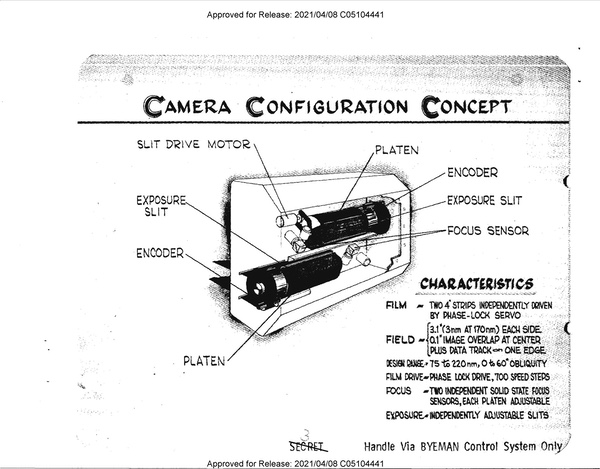 To increase film load and provide redundancy, FROG had two film supplies that could be exposed separately. (credit: NRO) |
Flax’s decision put FROG on hold for the next several years. Despite this, some study of film-readout technology continued. Film-readout was proposed for use in tactical reconnaissance aircraft such as the US Air Force RF-4C Phantom and RF-111, and the Navy’s RA-5C Vigilante, although the technology was not fielded.[13] It was also approved to be included in the baseline system as part of the Manned Orbiting Laboratory (MOL) program (the readout system was approved while a film-capsule system was canceled.) One concept for MOL included the astronauts developing film onboard and scanning it using technology nearly identical to that considered for FROG.[14] MOL was canceled in summer 1969. Work on this readout subsystem may have kept the technology alive for the few years after Flax had halted FROG development.
Although little work on FROG took place during this time, the program was still considered to be a potential competitor for a near-real-time reconnaissance satellite. By early 1971, it was competing against the CIA’s proposed ZAMAN system. ZAMAN would use a new electro-optical technology to take direct images that would then be beamed through a relay satellite to a ground station. But unlike FROG, ZAMAN relied on unproven technology. By spring 1971, the National Reconnaissance Office’s Executive Committee was considering which system to approve for development. In April, they approved FROG as an interim system until ZAMAN was ready.
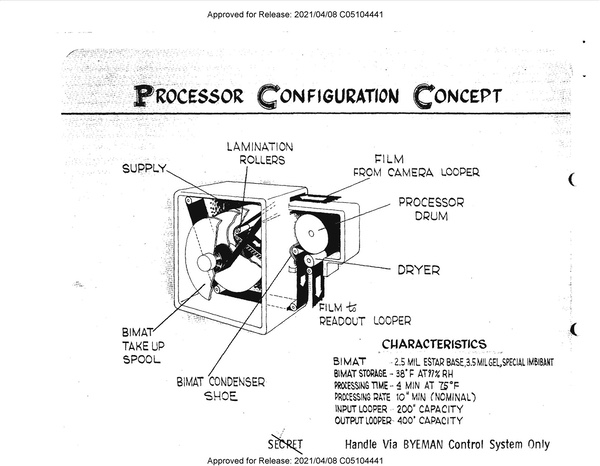 The film-developing system onboard FROG. This technology was relatively mature by the early 1970s. There was little question that it would work, only whether it was the best system compared to other technologies in development. (credit: NRO) |
The FROG vehicle
By early 1971 the FROG concept was relatively mature and relied on a number of proven systems. The FROG vehicle consisted of four parts: a modified GAMBIT-Agena that served as the orbital control vehicle, providing power and stabilization; a camera optics module using the GAMBIT R-5 version optics; a film electronic module providing film storage, processing, and readout; and a data link module that provided two wideband video channels to transmit imagery to ground stations.
The spacecraft would have a dual-wing solar array and a secondary propulsion system for adjusting and maintaining the orbit, conducting “crisis maneuvers,” and vehicle deboost at the end of mission. Although using existing equipment would have reduced costs and development time, there were still some changes required to the GAMBIT-Agena compared to the in-service version because of FROG’s longer mission lifetime.[15]
The Air Force was also looking at booster improvements such as increased turbine speed on the Titan III rocket, and a nozzle extension for the Agena. Those could provide up to 400 pounds (180 kilograms) or more additional lifting capability, which could be used to extend the lifetime of the FROG satellite.[16] There would be a 50% probability that the satellite would be operating at the end of one year. A launch rate of 2.8 per year would be required to maintain a two-satellite system. Increasing expendables, possible with improved booster performance, could substantially increase lifetime.[17]
The GAMBIT optical system would not require significant change for the FROG mission. Two “functionally independent film systems” were provided to minimize the risk of a single point failure. The film supply would be sufficient for a one-year mission with 25% contingency for “crisis modes.” The system was designed for an output rate of at least 200 frames per day.[18]
The film paths were enclosed and maintained at film vapor pressure. The temperature would be selectively controlled throughout the different portions of the pressure container.
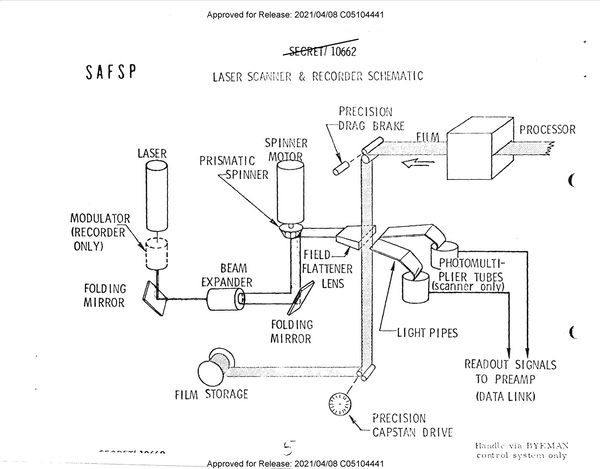 FROG had a number of moving parts, unlike the KH-11 KENNEN that eventually entered service in 1976. Some critics of FROG questioned how long these moving parts would last in orbit.(credit: NRO) |
The spacecraft would be launched from Vandenberg Air Force Base into a polar orbit. At nominal altitude of 170 nautical miles (314 kilometers), the payload would provide single or overlapping strip photography, with each strip covering three nautical miles (5.6 kilometers) at nadir. Resolution of the images processed on the ground would be around two feet (0.7 meters), although the resolution on the film itself would be around 18 inches (0.5 meters).[19] Like the standard GAMBIT-3 spacecraft, the camera could be operated to provide extended strip, stereo, lateral pair, and lateral triplet coverage in addition to single frame photography.
The camera was designed to operate throughout altitude ranges of 75–220 nautical miles (139-407 kilometers.) The camera would also have a selected focus sensor. Each sensor had a pair of detectors that sensed image sharpness ahead and behind the film plane.[20]
| By early 1971 the FROG concept was relatively mature and relied on a number of proven systems. |
Exposed film would be scanned by a laser scanner. The modulated light beam would be detected by a photo multiplier tube that produced a video signal. That signal would be transmitted to a single ground station at New Boston, New Hampshire. The satellite would use two wideband video channels. Each channel had 50 megahertz, and the video would use 40 megahertz in each channel. The remaining 10 megahertz of bandwidth in each channel would be used for housekeeping signals. It could achieve a readout rate of 14 pictures per minute of station contact time.
The New Boston ground station, also known as BOSS, would have a 46-foot (14-meter) antenna for communicating with the satellite. The satellite signal would be processed at the ground station and used to modulate the light beam of a laser beam recorder which reproduced the image directly on film. The film would then be processed and transported by courier to Washington, DC. A fully redundant readout station would be maintained at Vandenberg Air Force Base (known as COOK).
The BOSS station could also be equipped to simultaneously record the image on film and then transmit the video signal via a DSCS II communications satellite to Washington, DC, although the exact details remain classified. An additional ground station could be added at Kodiak in Alaska (designated KODI) to provide more frequent contacts with the FROG satellite.[21]
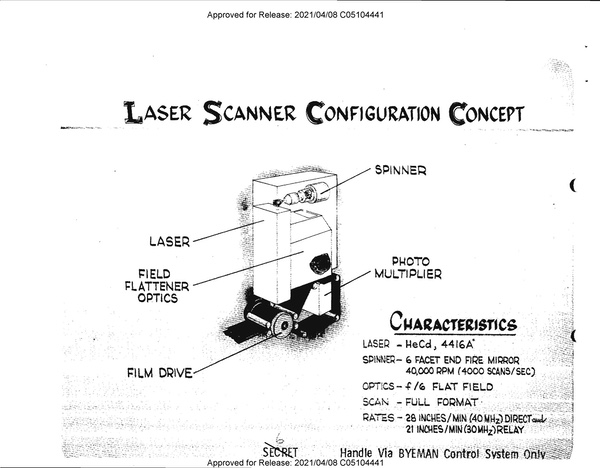 The FROG would have used a laser scanner, an improvement over the white light “flying spot scanner” used in the earlier Samos film-readout program. The laser was only a little over a decade old in 1971.(credit: NRO) |
The normal production would be 200 frames per day per satellite: 100 frames per day from each film path. The goal would be a maximum sustained rate of 400 frames per day per satellite or 800 frames per day with a two-satellite system.[22]
Each film path would hold 15,000 feet (4,570 meters) of film and BIMAT used in the developing process. A nominal mission required about 1,000 feet (305 meters) of film per path per month.[23] An alternative vehicle referred to as F* would have required a larger booster and carried 176,000 feet (53,645 meters) of film.[24]
During crisis situations—such as the 1968 Soviet invasion of Czechoslovakia—it was sometimes necessary to image large areas. This could be done by taking oblique photography of a crisis area, accomplished by rolling the camera to look far off the vehicle’s ground track. A two-satellite system would provide some photography of a crisis area every day, and a search of much of the Earth’s surface within two days.[25]
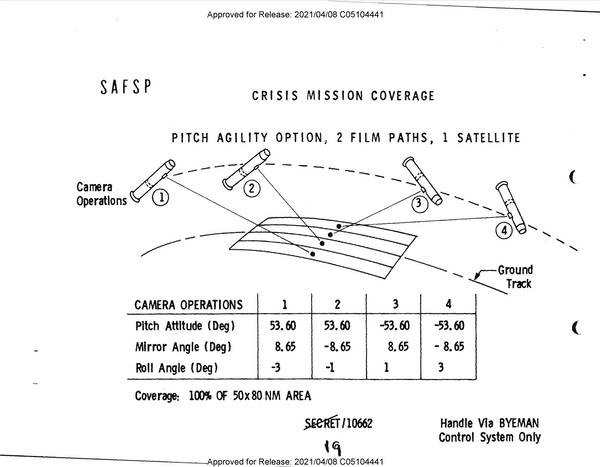 The FROG satellite could have been maneuvered to expand its coverage during crises. This became a concern after the 1968 Soviet invasion of Czechoslovakia. (credit: NRO) |
Another method of obtaining crisis imagery would be to pitch the satellite—tilting it above and below horizontal to shift the optical line of sight to access targets, or to increase camera operation time and swath width to provide additional area coverage.[26]
| Critics, particularly Edwin “Din” Land, the founder of Polaroid who had advised the government on top secret reconnaissance cameras since the 1950s, believed that approving FROG would delay development of a better system, and also claimed that FROG’s performance was overrated. |
In event of a crisis, where high resolution photography was needed, the satellite could be placed in a more elliptical orbit lowering its perigee to 85 nautical miles (157 kilometers), providing nadir resolution of about one foot (0.30 meters). This option could be sustained for about 15 days while keeping the ability to return to the routine 170-nautical-mile (315-kilometer) orbit. The satellite could also stay in the crisis orbit longer, up to 50 days, but not return to routine operations.[27]
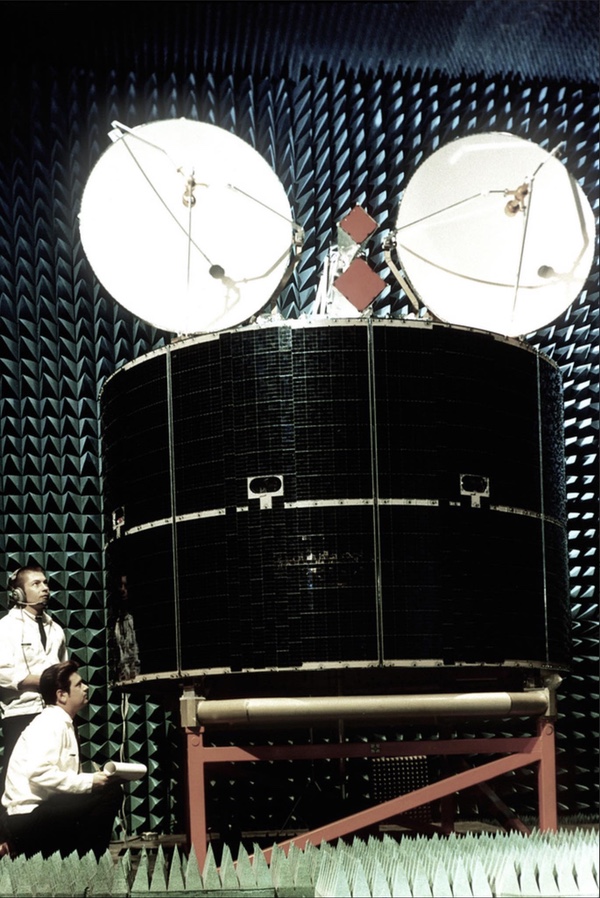 A Defense Satellite Communications System II (DSCS II) satellite undergoing testing. DSCS II could have been used to relay the imagery from the FROG ground station in New Hampshire to Washington, DC. (credit: USAF) |
Selected, then canceled
The total cost of eleven FROG vehicles through fiscal year 1977 would be $569 million.[28] In April 1971, the Executive Committee of the National Reconnaissance Office, which consisted of the Deputy Secretary of Defense and the Director of Central Intelligence, agreed to begin development of FROG, with the expectation that development of an electro-optical satellite that would replace FROG would soon follow. However, over the summer, there was substantial discussion of this decision, including direct appeals to senior leadership in the White House to reverse it. Critics, particularly Edwin “Din” Land, the founder of Polaroid who had advised the government on top secret reconnaissance cameras since the 1950s, believed that approving FROG would delay development of a better system, and also claimed that FROG’s performance was overrated.
By November 1971, FROG was canceled and a new electro-optical imaging program, then named ZAMAN, was approved. ZAMAN was quickly renamed KENNEN and pursued to full development. FROG was soon forgotten, although production of GAMBIT-3 satellites—using film-return technology—continued into the 1980s. Film-readout technology had its last gasp before it was abandoned.
Endnotes
- Robert Perry, “NRO History: NRO history Series Chapter 17, Vol. IV, Draft Only,” [version approved for release 3-19-2018], p. 37.
- Perry, p. 38.
- Perry, p. 38.
- Bruce C. Clarke, Jr., Special Assistant to the DDI for Special Projects, Memorandum, Subject: DDI Requirements in Connection with New Reconnaissance System, August 11, 1966; Oder, Fitzpatrick, and Worthman, The GAMBIT Story, p. 86.; Harold L. Brownman, Director of Special Projects, Memorandum for Deputy Director, National Reconnaissance Office, “EOI Briefing Charts Requested by Mr. Sorrels,” March 19, 1971. The limits of how many images FROG could take in high-density target areas are depicted in: Frank J. Denny, Executive Secretary, Committee on Imagery Requirements and Exploitation, Memorandum for holders of COMIREX – M – 127, “Interim Crisis-Response Planning- - Film Readout GAMBIT (FRO-G),” June 15, 1971, p. 32.
- John S. Foster, Jr., Director of Defense Research and Engineering, Memorandum for General Carroll, “Assessment of New Technology for Intelligence Collection,” n.d.
- Lieutenant General Joseph F. Carroll, USAF, Director of the Defense Intelligence Agency, to John S. Foster Jr., Director of Defense Research and Engineering, “Assessment of New Technology for Intelligence Collection,” March 18, 1966.
- Ibid.
- Ibid. In his history, Perry wrote that DIA had concluded that readout would be useful for augmenting electronic intelligence data on “special events of great interest to the scientific or technical areas.” Perry, p. 39.
- Ibid.
- Perry, p. 39.
- R.A. Koch, Captain, USN, Memorandum for Dr. Flax, “GAMBIT CUBED Readout Briefing Paper,” November 21, 1966.
- Perry, p. 39.
- Lieutenant General Joseph R. Holzapple, Deputy Chief of Staff, Research and Development, to AFRDC, “Photographic Readout System for Use in Reconnaissance Aircraft,” February 9, 1967.
- See, for example, “Initial Capability Readout System for Early Implementation Into the MOL/DORIAN System,” December 31, 1968.
- SAFSP, “FROG Film Readout GAMBIT,” n.d. but 1971, p. 2.
- Ibid., p. 9.
- Ibid., p. 12.
- Ibid., p. 4.
- Ibid., p. 28.
- Ibid., p. 6.
- John L. McLucas, Director, NRO, Memorandum for Mr. Packard, Mr. Helms, and Dr. David, “EXCOM Meeting,” April 20, 1971, p. 7.
- SAFSP, “FROG Film Readout GAMBIT,” p. 22.
- Ibid., p. 24.
- Edward E. David, Jr., Science Advisor, to David Packard, Deputy Secretary of Defense, July 11, 1971. Other variations of FROG were also considered by summer 1971; see here.
- SAFSP, “FROG Film Readout GAMBIT,” p. 38.
- Ibid., pp. 40-41.
- Ibid., p. 46.
- Ibid., p. 61. The non-recurring costs would be $165 million, with recurring costs of $103 million per year for 2.8 FROG spacecraft per year. The recurring costs per launch would be $30.4 million for the vehicle and $6.3 million for operations. Frank J. Denny, Executive Secretary, Committee on Imagery Requirements and Exploitation, Memorandum for holders of COMIREX – M – 127, “Interim Crisis-Response Planning- - Film Readout GAMBIT (FRO-G),” June 15, 1971, p. 36.
Note: we are using a new commenting system, which may require you to create a new account.
